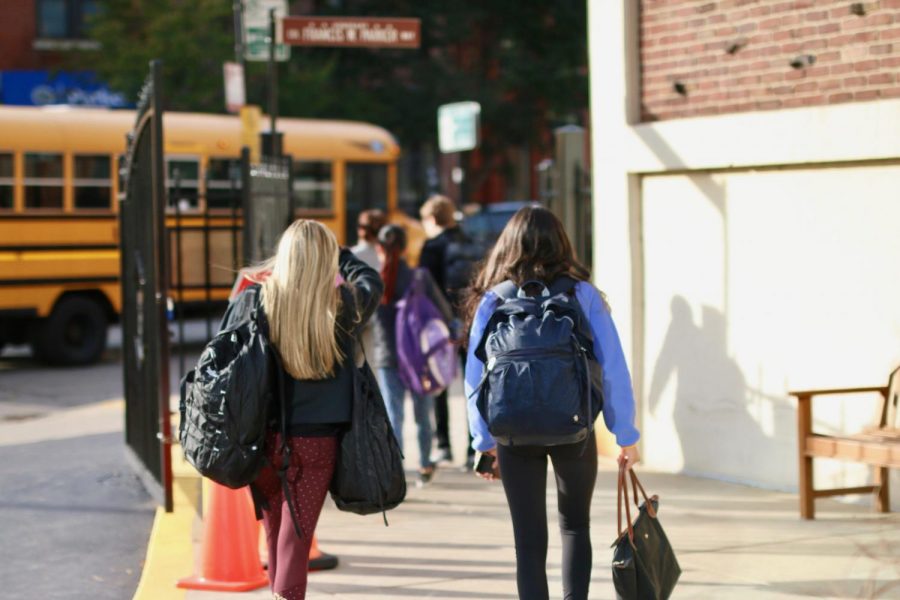Weight-ing for a Solution
The Ugly Truth About High Schoolers’ Backpacks
Photo credit: Jenna Mansueto
Students exit school, heavy backpacks in tow.
Riding a blue and black Divvy bike to school twenty minutes from his home, freshman Aidan Weinberg feels the weight of his cumbersome, grey, and neon-yellow Reebok backpack pull him down. On every turn, the bag gradually shifts all of its weight across his body. At Parker, he checks the contents of the bag: one 510 page, green latin textbook, an iPad encased in a royal blue cover, a black metal water bottle, a grey Chromebook laptop, two wide-ruled notebooks, a yellow copy of “Six Degrees of Separation,” and a black Nikon camera.
Because of a student government proposal putting iPad distribution in the high school to a halt for most students, high school students have been using more textbooks than they had been previously, which increased the severity of the issue of back pain.
Back pain caused by the weight of student belongings has become a heightened problem at Parker. “The thought I had about this, when I’ve thought about it in the past, is get a set of books to keep in the room and give everybody a book to take home so that you have your book in the classroom and then your book at home, so you’re not carrying it back and forth,” Nurse Anna Nelson said. “Doesn’t that sound like a genius idea?”
Extra textbooks, however, would cost a substantial amount of money. Recognizing the root of the problem, Nelson is trying to think of a more reasonable solution. “Here’s what I see as part of the problem: kids don’t want to go to their lockers during the day, so they carry their stuff all around with them,” Nelson said. “They’re like turtles with their houses on their backs.”
Because passing periods are five minutes, students are concerned that going to their lockers will earn them a tardy. “I think they should extend passing period time,” Weinberg said. “It’s flawless. If you add one minute to each, that’s enough time to go to your locker. The schedule’s already confusing, so shifting it eight minutes won’t really do anything.”
Such rescheduling, is tricky, though, because the upper school schedule needs to be consistent with those of the other two divisions, since some faculty work cross-divisionally.
Various professional news sources recognize this as a major health concern and long-term issue. According to Time Magazine, from August 31, 2015, “like the frame of a house, the spine is what keeps your child’s body sturdy and upright. Put too much weight on this frame while a young body is still developing and it could change a kid’s posture, compress his spine, and impair growth.”
Associate Professor at Northwestern Feinberg School of Medicine Ruchi Gupta, MD agrees. “What happens if you wear heavy backpacks too much is it could distort your natural curve especially in the middle and the lower part of your spine,” Gupta said. “Your muscles could be extra strained because your posture has changed, and it could cause pain and irritation really around that spine and your rib cage.”
Weinberg grasps the concept using an analogy. “My dad runs so he always talks about people having bad running form and how, if you have bad running form, and you keep doing bad running form, then it’s bad for your legs,” Weinberg said. “Then your legs have to develop muscles. Once you develop those muscles, then it will affect your hips, and eventually it’s just really bad for you.”
Weinberg sees the long-term health detriments. “My dad always complains about his back, and I’ve been complaining about my back,” Weinberg said. “I’m worried that I’m gonna have old man back problems when I’m not an old man. That’s not good.”
Librarian Annette Lesak recognizes the problem as well. “I would say that we, just to follow the trends in library and technology, we are offering more digital materials,” Lesak said. “And I think we’re trying to provide more access to technology in the library space to lighten students’ loads.”
Library policy has also changed. “We still are using books, but we have a policy that they stay here so other classes can use them, and they’re just taking photos of the pages that they need.”
In addition to steps the library is taking to reduce lower back pain, the seating set-up is designed to assist students with this problem. “One thing we are doing is offering a variety of seating,” Lesak said. “We are becoming more aware of how important movement is in education. We’re going to have adjustable height tables that can do stand-to-sit.”
While the library is working in these ways, Weinberg suggests that there is a simpler solution to the problem. “They never talk about proper posture,” Weinberg said. “So I think if they made that an important part of our lives…” and then he puffed his cheeks to produce a bomb sound effect while extending his hands.
The lower back pain high schoolers at Parker experience is consistent with the human evolutionary experience. “Low back pain is really common in people because we haven’t really been walking erect for that many years,” Nelson said. “Before we walked erect, we walked kind of down on all fours and maybe a little bit erect. With evolution, now we are fully standing, but it hasn’t been that long. The area that is weak in our bodies is our lower back because it doesn’t have the muscle structure to support it.”
Nelson recognizes another issue. “The other thing that most Americans have a problem with is we don’t have the abdominal structure, which is what you need to support your back fully,” she said. “You need to have really good abdominal muscles.”
Because strong abdominal muscles are crucial to combating lower back pain, Parker could consider adjusting its physical education classes to include more core exercises.
Also, students frequently view their phones in a position detrimental to their health– they tilt their heads downward, adding approximately sixty pounds of weight on their necks. Sixty pounds is roughly the size of an armchair or a large Everlast punching bag. “That’s a big issue,” Gupta said. “It leads to that additional bad posture, which leads to long-term neck-shoulder pain and strain. I think it’s really important for all students to try not to bend their head down and scrunch their shoulders.”
Because the phone-viewing posture has become a habit, in order to prevent further damage, Parker high school students could use a method utilized by the younger kids. “They have the backpacks on rolls like a suitcase,” Nelson said. “Those are better.”
The adoption of this method is not appealing to sophomore Pitts. “They are so uncool,” Pitts said. “It’s too much work to roll them down stairs.”
Given backpacks, Nelson has advice.“The only thing I will say is better if you’re gonna carry your backpack around is don’t carry it on one side,” Nelson said. “Have it on your whole back. If you have it on one side, then one side’s gonna be lower. Those muscles are gonna be stretched more than the other side. So, if you put it on both sides, that just evens out the weight.”
Having measured the weights of a number of backpacks of high school students, Nelson suggests a method to fully comprehend the dangers that stem from carrying heavy backpacks. “I think it’s a good idea for kids to think about ‘What am I carrying around in my backpack?’” Nelson said, “and even weigh it.”
According to Kids Health, a backpack should weigh no more than ten to fifteen percent of one’s body weight. Freshman Matthew Gordon’s backpack weighs 17.6 pounds, the approximate weight of a housecat, a chihuahua, and two guinea pigs combined, while Chris Torres carries a backpack weighing 20.8 pounds—the approximate weight of a dining chair.
Sophomore Matthew Turk’s backpack weighs 25.1 pounds, the approximate weight of a car tire and a table lamp combined, while Brooke Kolker’s backpack weighs 17.3 pounds—the approximate weight of a medium bag of dog food and two packages of butter combined.
Junior Amaya Contractor’s backpack weighs 18.2 pounds, the approximate weight of a medium size bowling bowl and three footballs combined, while Isabel Bouhl’s backpack weighs 20.2 pounds—the approximate weight of a karaoke machine.
Senior Charlie Rantala’s backpack weighs 11.5 pounds, the approximate weight of a housecat, while Talia Garg’s backpack weighs 10.5 pounds—the approximate weight of a large bag of potatoes.
“I can’t imagine the load that high schoolers are carrying,” Lesak said. “I think lightening the load we’re giving you guys and forcing you to carry around is a great thing to do.”








